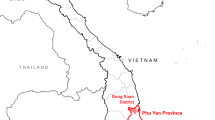Abstract
There has been increasing contact between mountain gorillas (Gorilla gorilla beringei) and the human population surrounding Bwindi Impenetrable Forest National Park (BIFNP) in Uganda. Due to the close taxonomic relationship between humans and gorillas there is potential for disease transmission between them. Preventing the introduction or spread of transmissible diseases to the gorillas is essential to protect them. We interviewed 301 villagers living in close proximity to BIFNP with a medical questionnaire in July, 2000. We collected information on demographics, vaccination and health history, and human/gorilla interaction. Our objectives were to estimate the prevalence of several diseases in the human population and to evaluate the risk of anthropozoonotic transmission from humans to gorillas. We found a high prevalence of disease symptoms such as coughing (72.1%) and fever (56.1%) compatible with acute infectious diseases; over half of the respondents (59.1%) had a specific disease diagnosis within the 6 mo preceding the study. We compared villagers who had visual contact with gorillas in the 6 mo preceding the study (53.5%) to villagers who had no visual contact (46.5%). Men were 2.3 times more likely than women to have visual contact with gorillas. In general, the frequency of disease history and symptoms was similar for people with and without contact. The high prevalence of acute infectious diseases in the population surrounding BIFNP and the high rate of contact with gorillas creates the potential for anthropozoonotic disease transmission.
Similar content being viewed by others
References
Adams, H. R., Sleeman, J. M., Rwego, I. B., and New, J. (2001). Self-reported medical history survey of humans as a measure of health risk to the chimpanzees (Pan troglodytes schweinfurthii) of Kibale National Park, Uganda. Oryx 35(4): 308-312.
Anon 1. (1997). Can the mountain gorilla survive?. Population and Habitat Viability Assessment for Gorilla gorilla beringei, Kampala, Uganda, Conservation Breeding Specialist Group, Apple Valley, MN.
Anon 2. (1997). Conserving the chimpanzees of Uganda. Population and Habitat Viability Assessment for Pan troglodytes schweinfurthii, Entebbe, Uganda, Conservation Breeding Specialist Group, Apple Valley, MN.
Anon 3. (1997). Statistical abstract. Ministry of Planning and Economic Development, Republic of Uganda.
Hastings, B. E., Kenny, D., Lowenstine, L. J., and Foster, J. W. (1991). Mountain gorillas and measles: Ontogeny of a wildlife vaccination program. In Proceedings AAZV Annual Meeting. pp. 198-205.
Klema, G., Kock, R. A., and Macfie, E. J. (1998). An outbreak of sarcoptic mange in free-ranging mountain gorills (Gorilla gorilla beringei) in Bwindi Impenetrable Forest, Southwest Uganda. In Proceedings AAZV/AAWV Joint Conference. p. 438.
Kortlandt, A. (1996). An epidemic of limb paresis (polio?) among the chimpanzee population at Beni (Zaire) in 1964, possibly transmitted by humans. Pan Africa News 3(2): 9-10.
Macfie, L. (1996). Case report on scabies infection in Bwindi gorillas. Gorilla J. 13: 19-20.
McCallum, H., and Dobson, A. (1995). Detecting disease and parasite threats to endangered species and ecosystems. Trends Ecol. Evol. 10(5): 190-194.
Mukadi, Y. D., Maher, D., and Harries A. (2001). Tuberculosis case fatality rates in high HIV prevalence populations in sub-Saharan Africa. AIDS 15(2): 143-152.
Murray, S., Stem, C., and Goodall, J. (1991). Intestinal parasites of baboons and chimpanzees in Gombe Nationl Park. In Proceedings AAZV Annual Meeting. pp. 244-245.
Nizeyi, J. B., Rwego, I., Erume, J., Kalema, G., Cranfield, M., and Graczyk, T. (2001). Campylobacteriosis, Salmonellosis, and Shigellosis in free-ranging human-habituated mountain gorillas of Uganda. J. Wildlife Dis. 37(2): 239-244.
Ott-Joslin, J. E. (1993). Zoonotic diseases of nonhuman primates. In Fowler, M. E. (ed.), Zoo and Wild Animal Medicine, W.B. Saunders Philadelphia, pp. 358-373.
Sleeman, J. M., Meader, L., Mudakikwa, A. B., Foster, J., and Patton, S. (2000). Gastrointestinal Parasites of Mountain Gorillas (Gorilla gorilla beringei) in the Parc National Des Volcans, Rwanda. J Zoo Wildlife Med. 31(3): 322-328.
Sleeman, J. M., and Rooney, M. (2000). Determining the human diseases transmissible to the great apes of Uganda. In Proceedings AAZV/IAAAM Joint Conference, September 2000.
Uganda AIDS Commission. (2001). Scaling-up the HIV/AIDS and orphans response to accelerate poverty reduction in Uganda. http://www.aidsuganda.org/nationalupdates.htm
Wallis, J., and Lee, D. R. (1999). Primate conservation: The prevention of disease transmission. Int. J. Primatol. 20(6): 803-827.
Wolfe, N. D., Escalante, A. A., Karesh, W. B., Kilborn, A., and Spielman, A. (1998). Wild primate populations in emerging infectious disease research: The missing link? Emerg. Infect. Dis. 4(2):149-158.
World Health Organization. (2001). WHO Report 2001: Global tuberculosis control. http://www.who.int/gtb/publications/globrep01/index.html
Author information
Authors and Affiliations
Rights and permissions
About this article
Cite this article
Guerrera, W., Sleeman, J.M., Jasper, S.B. et al. Medical Survey of the Local Human Population to Determine Possible Health Risks to the Mountain Gorillas of Bwindi Impenetrable Forest National Park, Uganda. International Journal of Primatology 24, 197–207 (2003). https://doi.org/10.1023/A:1021410931928
Issue Date:
DOI: https://doi.org/10.1023/A:1021410931928




